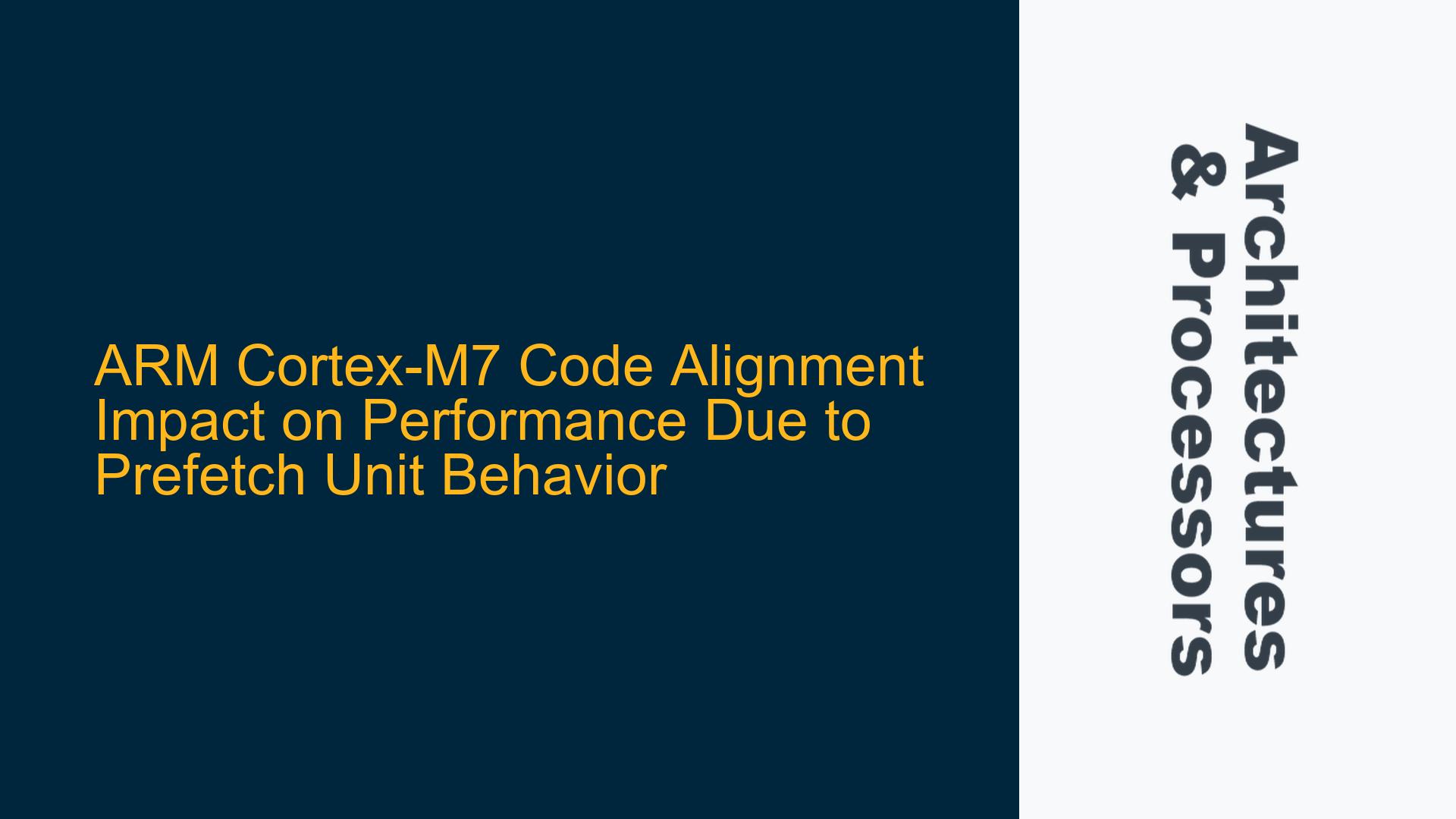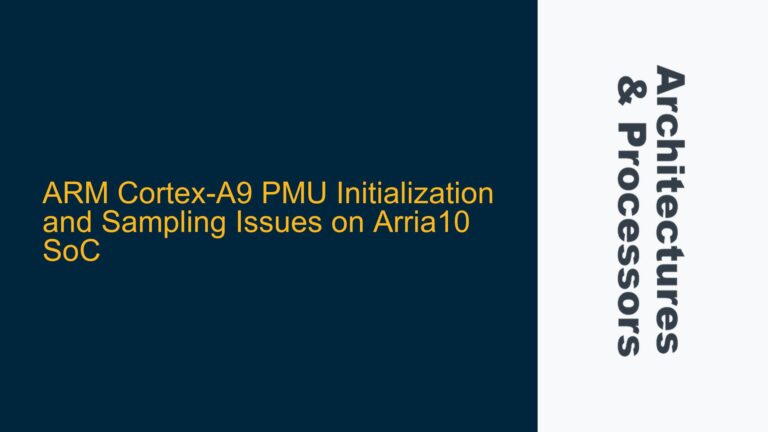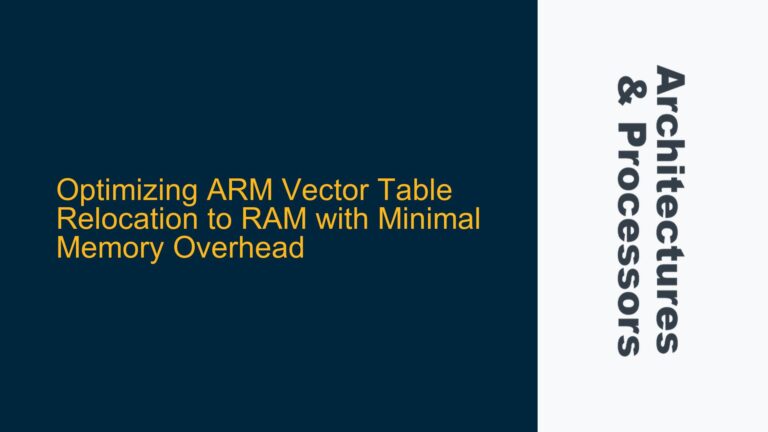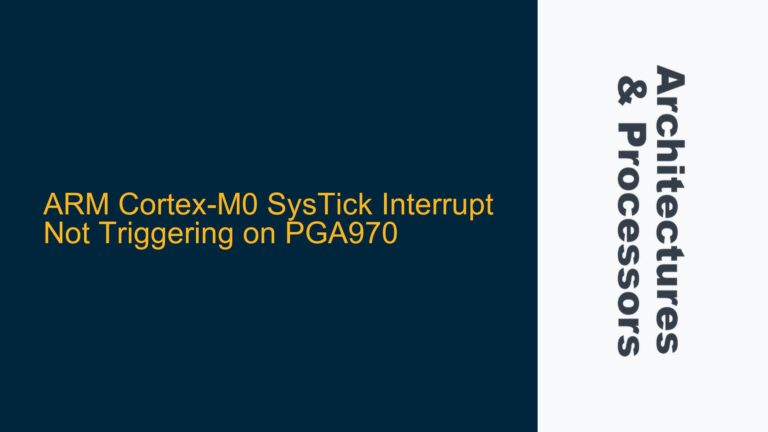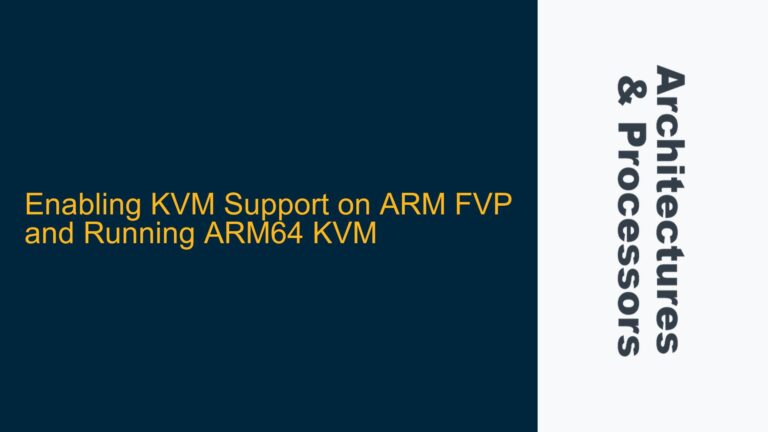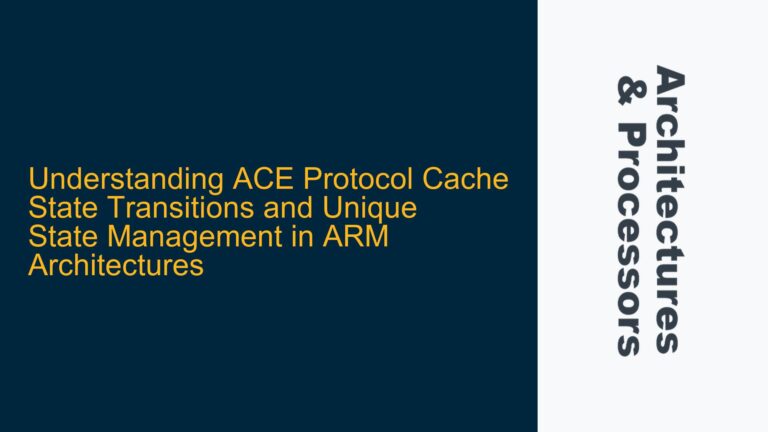ARM Cortex-M7 Prefetch Unit and Instruction Fetch Efficiency
The ARM Cortex-M7 processor, known for its high performance and efficiency, incorporates several advanced features to optimize instruction execution. One such feature is the Prefetch Unit (PFU), which plays a critical role in fetching instructions from memory and feeding them into the processor’s pipeline. The PFU is designed to maximize instruction fetch bandwidth and minimize latency, but its behavior can be significantly influenced by the alignment of code in memory. This alignment can lead to unexpected performance variations, especially in tight loops where instruction fetch efficiency is paramount.
The Prefetch Unit in the Cortex-M7 is equipped with a 64-bit instruction fetch bandwidth, meaning it can fetch up to 64 bits of instructions in a single cycle. Additionally, it includes a 4×64-bit pre-fetch queue that decouples instruction pre-fetch from the Data Processing Unit (DPU) pipeline operations. This queue allows the PFU to pre-fetch instructions ahead of time, reducing the likelihood of pipeline stalls due to instruction fetch delays. However, the efficiency of this pre-fetching mechanism is highly dependent on the alignment of instructions in memory.
When instructions are aligned on 64-bit boundaries, the PFU can fetch entire instruction bundles in a single cycle, maximizing throughput. However, if instructions are misaligned, the PFU may need to perform additional fetches to retrieve the same set of instructions, leading to increased latency and reduced performance. This is particularly evident in tight loops, where the same set of instructions is executed repeatedly. In such cases, even a small misalignment can result in significant performance degradation due to the cumulative effect of additional fetch cycles over many iterations.
Instruction Alignment and Cache Interaction in Cortex-M7
The Cortex-M7 also features an Instruction Cache (I-Cache), which is designed to store frequently accessed instructions to reduce the need for repeated fetches from slower memory. However, the interaction between the I-Cache and the Prefetch Unit can further complicate the performance impact of instruction alignment. When the I-Cache is enabled, instructions are first fetched from the cache, reducing the reliance on the PFU for instruction fetch operations. However, the alignment of instructions in the cache can still affect performance, as the cache itself operates on fixed-size cache lines.
In the Cortex-M7, the I-Cache typically operates with 32-byte cache lines. When instructions are aligned on cache line boundaries, the cache can efficiently store and retrieve entire lines of instructions, minimizing the number of cache accesses required. However, if instructions are misaligned, the cache may need to fetch additional lines to retrieve the same set of instructions, leading to increased cache access latency and reduced performance. This effect is particularly pronounced in tight loops, where the same cache lines are accessed repeatedly.
Moreover, the Cortex-M7’s Branch Target Address Cache (BTAC) and static branch predictor can also be influenced by instruction alignment. The BTAC is designed to store the target addresses of branch instructions, allowing for single-cycle turn-around of branch predictor state and target address. However, if branch instructions are misaligned, the BTAC may not be able to efficiently predict branch targets, leading to increased branch misprediction penalties and further performance degradation.
Optimizing Code Alignment for Cortex-M7 Performance
To mitigate the performance impact of instruction misalignment on the Cortex-M7, developers can take several steps to optimize code alignment. One approach is to ensure that critical loops and frequently executed code segments are aligned on 64-bit boundaries. This can be achieved by inserting NOP instructions or using compiler directives to enforce alignment. By aligning critical code segments, the Prefetch Unit can fetch entire instruction bundles in a single cycle, maximizing throughput and reducing latency.
Another approach is to leverage the Cortex-M7’s I-Cache by ensuring that frequently accessed instructions are aligned on cache line boundaries. This can be achieved by organizing code into cache-aligned sections and using compiler directives to enforce cache line alignment. By aligning instructions on cache line boundaries, the I-Cache can efficiently store and retrieve entire lines of instructions, minimizing cache access latency and improving performance.
Additionally, developers can use the Cortex-M7’s Branch Target Address Cache (BTAC) and static branch predictor to optimize branch performance. By aligning branch instructions on 64-bit boundaries, the BTAC can efficiently predict branch targets, reducing branch misprediction penalties and improving overall performance. This can be achieved by inserting NOP instructions before branch instructions or using compiler directives to enforce alignment.
In conclusion, the alignment of instructions in memory can have a significant impact on the performance of the ARM Cortex-M7 processor, particularly in tight loops and frequently executed code segments. By understanding the behavior of the Prefetch Unit, I-Cache, and BTAC, developers can optimize code alignment to maximize performance and minimize latency. This involves aligning critical code segments on 64-bit boundaries, organizing code into cache-aligned sections, and aligning branch instructions to optimize branch prediction. By taking these steps, developers can ensure that their code runs efficiently on the Cortex-M7, leveraging its advanced features to achieve optimal performance.
Cortex-M7 Prefetch Unit and Instruction Fetch Efficiency
The Cortex-M7’s Prefetch Unit (PFU) is a critical component in the processor’s instruction fetch mechanism. It is designed to fetch instructions from memory and feed them into the processor’s pipeline with minimal latency. The PFU operates with a 64-bit instruction fetch bandwidth, allowing it to fetch up to 64 bits of instructions in a single cycle. This high fetch bandwidth is essential for maintaining the processor’s performance, especially in applications with high instruction throughput requirements.
However, the efficiency of the PFU is highly dependent on the alignment of instructions in memory. When instructions are aligned on 64-bit boundaries, the PFU can fetch entire instruction bundles in a single cycle, maximizing throughput. This is particularly important in tight loops, where the same set of instructions is executed repeatedly. In such cases, even a small misalignment can result in significant performance degradation due to the cumulative effect of additional fetch cycles over many iterations.
For example, consider a tight loop that consists of three instructions: a NOP, a subtract instruction, and a branch instruction. If these instructions are aligned on a 64-bit boundary, the PFU can fetch all three instructions in a single cycle, minimizing fetch latency and maximizing performance. However, if the instructions are misaligned by just two bytes, the PFU may need to perform an additional fetch to retrieve the same set of instructions, leading to increased latency and reduced performance.
This behavior is particularly evident in the Cortex-M7, where the PFU’s 4×64-bit pre-fetch queue is designed to decouple instruction pre-fetch from the DPU pipeline operations. The pre-fetch queue allows the PFU to pre-fetch instructions ahead of time, reducing the likelihood of pipeline stalls due to instruction fetch delays. However, if instructions are misaligned, the pre-fetch queue may not be able to efficiently pre-fetch instructions, leading to increased fetch latency and reduced performance.
Instruction Alignment and Cache Interaction in Cortex-M7
The Cortex-M7’s Instruction Cache (I-Cache) is another critical component that can be influenced by instruction alignment. The I-Cache is designed to store frequently accessed instructions, reducing the need for repeated fetches from slower memory. However, the alignment of instructions in the cache can significantly affect performance, as the cache itself operates on fixed-size cache lines.
In the Cortex-M7, the I-Cache typically operates with 32-byte cache lines. When instructions are aligned on cache line boundaries, the cache can efficiently store and retrieve entire lines of instructions, minimizing the number of cache accesses required. However, if instructions are misaligned, the cache may need to fetch additional lines to retrieve the same set of instructions, leading to increased cache access latency and reduced performance.
For example, consider a tight loop that consists of three instructions: a NOP, a subtract instruction, and a branch instruction. If these instructions are aligned on a 32-byte cache line boundary, the I-Cache can efficiently store and retrieve the entire loop in a single cache access, minimizing cache access latency and maximizing performance. However, if the instructions are misaligned by just two bytes, the I-Cache may need to fetch an additional cache line to retrieve the same set of instructions, leading to increased cache access latency and reduced performance.
Moreover, the Cortex-M7’s Branch Target Address Cache (BTAC) and static branch predictor can also be influenced by instruction alignment. The BTAC is designed to store the target addresses of branch instructions, allowing for single-cycle turn-around of branch predictor state and target address. However, if branch instructions are misaligned, the BTAC may not be able to efficiently predict branch targets, leading to increased branch misprediction penalties and further performance degradation.
For example, consider a branch instruction that is misaligned by two bytes. In this case, the BTAC may not be able to efficiently predict the branch target, leading to increased branch misprediction penalties and reduced performance. This effect is particularly pronounced in tight loops, where the same branch instruction is executed repeatedly.
Optimizing Code Alignment for Cortex-M7 Performance
To mitigate the performance impact of instruction misalignment on the Cortex-M7, developers can take several steps to optimize code alignment. One approach is to ensure that critical loops and frequently executed code segments are aligned on 64-bit boundaries. This can be achieved by inserting NOP instructions or using compiler directives to enforce alignment. By aligning critical code segments, the Prefetch Unit can fetch entire instruction bundles in a single cycle, maximizing throughput and reducing latency.
For example, consider a tight loop that consists of three instructions: a NOP, a subtract instruction, and a branch instruction. By inserting a NOP instruction at the beginning of the loop, the loop can be aligned on a 64-bit boundary, allowing the PFU to fetch all three instructions in a single cycle. This can significantly reduce fetch latency and improve performance, especially in tight loops where the same set of instructions is executed repeatedly.
Another approach is to leverage the Cortex-M7’s I-Cache by ensuring that frequently accessed instructions are aligned on cache line boundaries. This can be achieved by organizing code into cache-aligned sections and using compiler directives to enforce cache line alignment. By aligning instructions on cache line boundaries, the I-Cache can efficiently store and retrieve entire lines of instructions, minimizing cache access latency and improving performance.
For example, consider a tight loop that consists of three instructions: a NOP, a subtract instruction, and a branch instruction. By organizing the loop into a cache-aligned section, the I-Cache can efficiently store and retrieve the entire loop in a single cache access, minimizing cache access latency and maximizing performance.
Additionally, developers can use the Cortex-M7’s Branch Target Address Cache (BTAC) and static branch predictor to optimize branch performance. By aligning branch instructions on 64-bit boundaries, the BTAC can efficiently predict branch targets, reducing branch misprediction penalties and improving overall performance. This can be achieved by inserting NOP instructions before branch instructions or using compiler directives to enforce alignment.
For example, consider a branch instruction that is misaligned by two bytes. By inserting a NOP instruction before the branch instruction, the branch instruction can be aligned on a 64-bit boundary, allowing the BTAC to efficiently predict the branch target. This can significantly reduce branch misprediction penalties and improve performance, especially in tight loops where the same branch instruction is executed repeatedly.
In conclusion, the alignment of instructions in memory can have a significant impact on the performance of the ARM Cortex-M7 processor, particularly in tight loops and frequently executed code segments. By understanding the behavior of the Prefetch Unit, I-Cache, and BTAC, developers can optimize code alignment to maximize performance and minimize latency. This involves aligning critical code segments on 64-bit boundaries, organizing code into cache-aligned sections, and aligning branch instructions to optimize branch prediction. By taking these steps, developers can ensure that their code runs efficiently on the Cortex-M7, leveraging its advanced features to achieve optimal performance.
